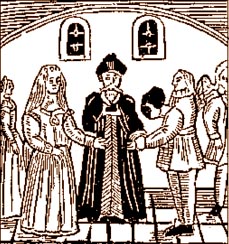Are you ready for online dating? Take a QUIZ to find out! |
||
Dating is a relatively new concept. However, the concept of courtship and the ritual of marriage have existed forever. I think that the history of courtship/dating will allow us to assess the changing dating trends, and help us to see the reasons behind the emergence and success of the online dating industry.
Colonial Times to 1830 During Colonial America, marriage was highly encouraged. In fact, in some colonial towns, bachelors were harassed, fined or forced to leave the town. Singleness was seen as a sign of laziness (Cate and Lloyd, 1992). Marriage was less about romance and love and more about men finding women who could bear children to help share the heavy workload that frontier life demanded. Women chose their husbands by their ability to support a wife and family was also very important. Similar social standing and family approval were also important. During this time, the idea of the "separate spheres" of men and women began to form. This separation also limited the ability of adolescent boys and girls to get to know one another. At puberty, girls entered the "female world" and boys in the "male world."
Courtship became more formalized. Romantic love began to flourish and was viewed as the only acceptable basis for marriage. Romantic love during this time contained not only elements of passion, but also mutuality, communion, sympathy, and openness. This was important to women because it gave them an assurance of long-term commitment. Suitor's were tested to see how strong their love/commitment was. The link between marriage and making a home was strong. A man's readiness for marriage was seen by his ability to provide a home for his new wife. From 1880 to 1920Romance started to play an increasingly important role during this period. However, dating was still a formal, elaborate, and slow procedure. During the late 19th century, men were seen as depraved and immoral beings. Many literary and historical figures during that time wrote about men's savage-nature and their inability to control their animal passions. Accordingly, there was a distinct separation of the male and female spheres. The lives of young men and women rarely intersected. And, when they were together, the propriety of the times required that they keep their distance from each other. The process of dating and marriage was all under the watchful eyes of the parents. Chaperones went along on the young couples' dates (Cate and Lloyd, 1992). From 1920 to 1945 During this time, the notion of dating and courtship became separate entities. Dating became a vehicle for 'getting to know' someone and trying to establish a good impression, while courtship focused on finding a mate. Dating began earlier for people during this era (Cate and Lloyd, 1992). Boys and girls started dating in elementary schools and junior high schools. This put a greater importance on dating and establishing romantic relationships. The late 1900's gave women more freedom and independence. With the invention of birth control pills and start of the feminist movement, the women's role evolved. Many postponed marriage to explore college and career. Marriage and childbirth were seen as "oppression and exploitation" of women. This feminist reexamination of marriage and gender had a pronounced effect on courtship and dating. Women were able to make their own choices, in regards to dating and marriage. Also, since women were entering the workforce and making their own income, they looked less at the man's ability to provide for the family and earn money. Instead, women sought to find partners with common interests and hobbies. |
 |
|







